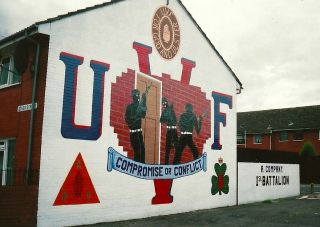Motivation
Evaluating Conflict Resolution: An Introduction
The motivation behind a research program on evaluating conflict resolution
Posted November 20, 2012

Protestant paramilitary mural
In the late 1990s, Ireland was in the heat of "The Troubles." Over the course of the previous 25 years, thousands of people had been killed by rival Catholic and Protestant paramilitaries. In Northern Ireland, the partisan rivalries played out during the day through massive murals that adorned the sides of most buildings — here history was told and territory was staked and defended. This is the Ireland that I entered as a volunteer at a conflict resolution camp in Galway, Ireland in 1997. The camp brought together Catholic and Protestant children, and like many of these programs, it had the kids engage in cooperative games and activities, dialogues and group discussions. For a number of participants, this camp seemed to be a great success: when I met up with a small group of the children in Belfast after the camp, they were eager to cross partisan lines to meet up with their new friends, despite the personal risk. But I would discover that evening when I sat down for a pint with a fellow volunteer that there was another side to the camp. She told me that after I had left camp

Protestant and Catholic children in Belfast post-camp with the author
with the first load of counselors and children, a fight had broken out between two kids. The group was immediately split down partisan lines, and a full-scale brawl erupted involving 150 children.
What should we take from this experience? How do we balance the relative weights of the positive and negative outcomes? What metric should we use to determine if an intervention or a program is ‘successful’? Are there some things that the camp did that were particularly effective or ineffective? Are there other programs out there that would have done better? These were the questions that I left Ireland with. I brought them with me when I resumed my job as a high school science teacher, I carried them through a PhD program in neuroscience, and I finally yielded to their fierce urgency by taking them up as a formal research program as a postdoctoral fellow at MIT. This research program, done in collaboration with Rebecca Saxe, has two main themes: first, to evaluate existing conflict resolution programs using the best psychology tools available, and second, to develop ways of measuring the neural foundation of intergroup processes relevant to conflict using fMRI.
Why measure the effect of conflict resolution programs?
The conflict resolution movement began in earnest at the end of the Cold War, and there are now thousands of programs around the world that aim to decrease intergroup animosity and find peaceful solutions to ethnic conflicts. The vast majority of these programs, including the one I was involved with in Ireland, rely on the intuition of the people who developed the program. While intuition is incredibly helpful, it has its limitations. As a friend is fond of saying, intuitive physics enables you to catch a ball, but you can't rely on it to land you on the moon. Similar lessons have been learned recently as evidence-based medicine has begun (slowly) to supersede intuitive medicine, and the Obama campaign’s data-driven approach proved its superiority over traditional intuitive politics. I believe deeply in the mission of conflict resolution and diversity training programs. I have great hope that they can work. The invisible hands of our own psychological biases play a role in driving conflict and preventing its resolution, and I firmly believe that these biases can be illuminated, changed, and even overcome. I've felt this happen in myself, I've seen it happen in others (including those kids from the camp in Ireland). The challenge is to maximize the positive effect of programs that aim to do this good work — to give them a metric by which to judge their impact, and evaluate the effects of program innovations. While the virtues of mathematically-based physics, evidence-based medicine and statistically-informed politics are becoming clear, very little has ever been done to quantitatively evaluate the effect of conflict resolution programs.
Measuring psychological biases is not easy: people are unwilling to admit the biases that they’re aware of, and many of the intergroup biases we hold are not even accessible to introspection. But new tools are becoming available. New approaches are being taken. In this blog I will explore some of these efforts, and will also examine some of the larger questions about intergroup conflict: what are the origins of group conflict? What motivates us to harm — or condone harming — others? What roles do empathy, humiliation and betrayal play in conflict? How does a group’s power interact with the psychological impact of conflict, or conflict resolution efforts? What are the best ways to get us to care about ‘the other’?
I look forward to this intellectual journey, and I would love company.


